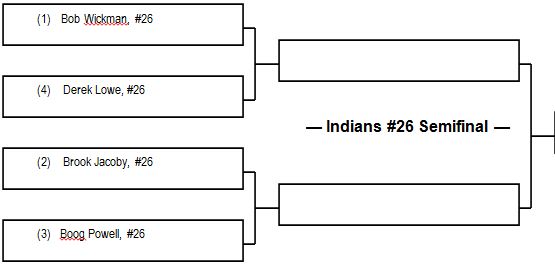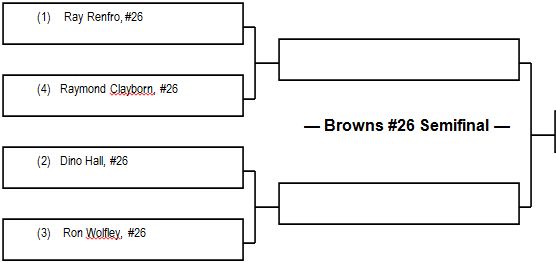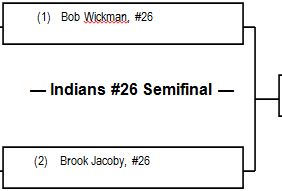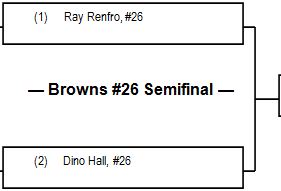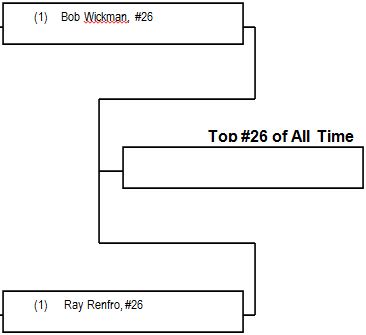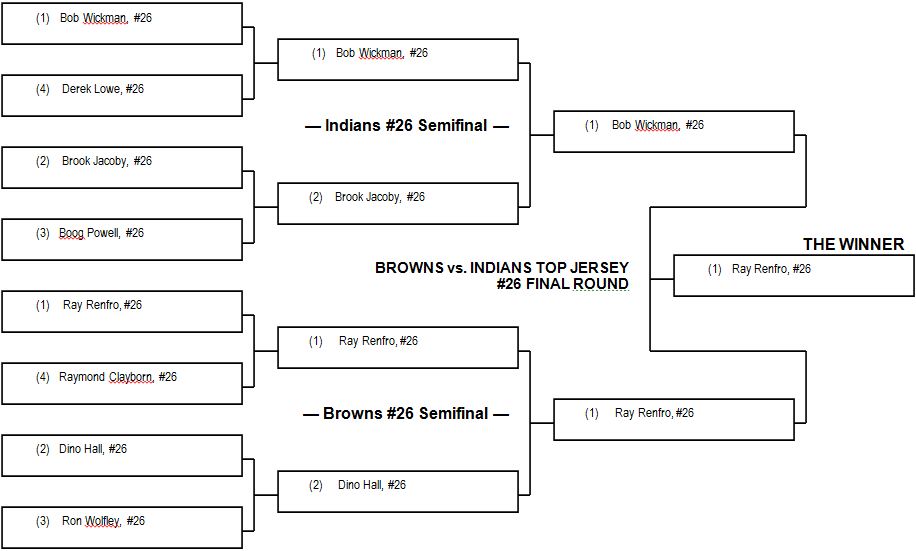 General
General  General Archive
General Archive  Top Cleveland Sports Figures, By the Numbers. #26
Top Cleveland Sports Figures, By the Numbers. #26
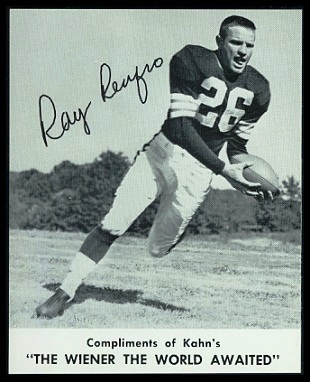 This is one installment in a team effort by The Cleveland Fan, highlighting the top local sports figures by jersey number. Please weigh in with your thoughts, in the Boards. As David Letterman would say, “For entertainment purposes only; please, no wagering.”
This is one installment in a team effort by The Cleveland Fan, highlighting the top local sports figures by jersey number. Please weigh in with your thoughts, in the Boards. As David Letterman would say, “For entertainment purposes only; please, no wagering.”
In Cleveland in March, two songs from the recent holiday season can seem oddly appropriate. The significance of each is diametrically opposed to the other.
"It’s beginning to look a lot like Christmas…” Yeah, we’ll move on from that one.
“It’s the most, wonderful tiiiiime, of the yearrrr.” There we go.
The 2013 Tribe has injected life into its fan base with their offseason acquisitions. Kyrie and the Cavaliers are providing a glint of optimism for their future. The Browns have free agency and the NFL draft on their horizon. And with the NASCAR season beginning anew, the weekly rhythm of truck race, Nationwide race, and Cup race will provide nine more months of its own brand of competition, soap opera intrigue and family room nap opportunities. (Did I say that out loud?)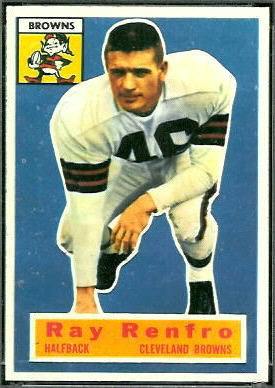
Since we also are entering the season of Bracketology, we thought it would be fun to offer a bracket format for the Elite Eight of Cleveland sports figures who have donned the number 26 over the years. Locally, that jersey has not been relatively popular among pro athletes over the decades. Still, there are several worthy nuggets from the past that we can recall.
The number 26 is the first of the non-negative integers (yes, I looked that up) that has never been used by a Cleveland Cavalier. So, nothing to see here; let’s move on.
What we can do is fill separate sides of our bracket with Indians and Browns, respectively. Here are the ‘bubble’ players who did not make the Big Dance:
Indians:
Sal Maglie. He was a prominent pitcher in the 1950s, mainly with the New York Giants and Brooklyn Dodgers. He only had the proverbial ‘cup of coffee’ in Cleveland, prior to his stint in Brooklyn.
Hoyt Wilhelm. Wilhelm had a very long career in the big leagues, spending just a short time with the Tribe in the late 1950s. His knuckleball resulted in a very high number of passed balls by Indians catchers. General manager Frank Lane is said to have been alarmed by this, and he exposed (and lost) the pitcher to waivers. Wilhelm would pitch until 1972, and was eventually elected to the Baseball Hall of Fame. It strikes me as funny: Lane couldn’t wait to trade his roster away. It’s what he is (in)famous for. He even traded managers once. Yet he simply released a 36 year old, future Hall of Fame veteran pitcher who had about fourteen more seasons in him. If he’d traded Wilhelm for some prospect who’d never make the big leagues, Lane would perhaps have been more vilified, vs. just releasing him.
Browns
Billy Lefear. ...Nah, Lefear really wasn’t really a ‘bubble’ guy. I just liked him when I was a little kid. He was a kick returner in the early 1970s, and broke a couple.
Abe Elam. Again, not close. A recent Browns defensive back; I just liked the way Browns announcer Jim Donovan enunciated his name: “Aye Beelam”.
***
Presenting the Cleveland Number 26 Elite Eight bracket (unfortunately, Greg Gumbel and Clark Kellogg were unavailable). Cue the upbeat background track:
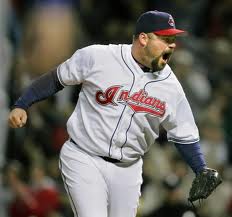
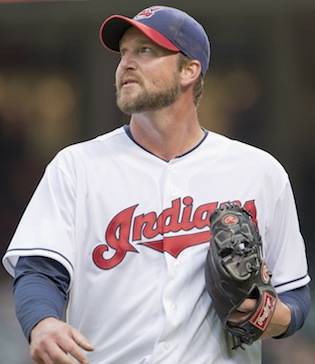 In the Cleveland Indians bracket, the number one seed is Bob Wickman. The sinker ball pitcher was acquired in 2000 by the Tribe, in a multi-player deal that sent first baseman Richie Sexson to the Milwaukee Brewers. He was the Tribe’s closer from 2000 to 2006.
In the Cleveland Indians bracket, the number one seed is Bob Wickman. The sinker ball pitcher was acquired in 2000 by the Tribe, in a multi-player deal that sent first baseman Richie Sexson to the Milwaukee Brewers. He was the Tribe’s closer from 2000 to 2006.
The player Wickman will face in the first round is the four seed, pitcher Derek Lowe. Lowe, who overtook outfielder Austin Kearns in the play-in matchup, was a starting pitcher whom the Tribe picked up prior to the 2012 season. He played for them for that one season.
The two seed in the Indians bracket is third baseman Brook Jacoby. Jacoby came up in the Atlanta Braves’ system, and in 1983, he was traded along with 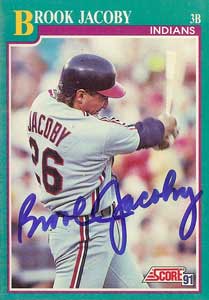
 outfielder Brett Butler and pitcher Rick Behenna to Cleveland, for Mr. Perfect, Len Barker. Jacoby toiled with the Tribe from 1984 to 1991, and then again for a short time in 1992.
outfielder Brett Butler and pitcher Rick Behenna to Cleveland, for Mr. Perfect, Len Barker. Jacoby toiled with the Tribe from 1984 to 1991, and then again for a short time in 1992.
Jacoby will square off against the number three seed, Boog Powell. Powell was acquired along with pitcher Don Hood from the Baltimore Orioles prior to the 1975 season, in exchange for catcher Dave Duncan. He spent most of three seasons with the Tribe.
So here again is your Indians bracket.
In the Cleveland Browns bracket, the number one seed belongs to running back Ray Renfro. The speedy Renfro came to the Browns in the 1952 NFL Draft, out of North Texas State. He played for the Browns his entire career, which lasted through the 1963 season.
In the first round, Renfro will take on the four seed: Raymond Clayborn. Clayborn was a three-time Pro Bowl wide receiver over a thirteen-year career with the New England Patriots. The Browns signed him to a free agent contract in 1990, and he spent two seasons in Cleveland.
Dino Hall has earned the number two seed in the Browns bracket. Hall was signed as an undrafted free agent out of Glassboro State in 1979. He was a kick returner/backup running back whose career spanned five seasons, all with the Browns.
Hall is matched up against the three seed, Ron Wolfley. Wolfey was a running back/special teams player who is perhaps best known as a St. Louis/Phoenix Cardinal. The Browns signed the seven-year veteran in 1992, and he spent two seasons in Cleveland.
Here is a look, then, at your Browns bracket.
In the Indians’ first round, let’s see what the underdog Derek Lowe offers in his matchup with Bob Wickman. (It is important to note that a top seed has never lost in the first round.) Lowe appeared washed up when he joined the Tribe prior to 2012. Indians fans’ opinions of acquiring him were linked to the Altlanta Braves’ ‘eating’ $10mil of his $15mil contract. Some liked the low level of risk with Lowe. Others said if the Braves would pay so much just to be rid of him, how much could he have left in the tank?
As a key contributor of the team’s hot first half of the season, Lowe compiled a 6-1 record out of the gate. Unfortunately, he followed that up by losing 9 of his last 11 games. His ERA on the season ballooned north of 5.50. By August, the Indians were out of the race and playing the kids. They released Lowe to make room for prospect Corey Kluber.
Bob Wickman had several successful seasons as the closer for the Tribe. That is enough to survive and advance past Lowe.
In the other first round matchup in the Indians bracket, Boog Powell seems likely to give Brook Jacoby a run for his money. Powell had had a long, successful career for the World Series champion Baltimore Orioles. By the time he joined Tribe manager (and former Orioles teammate) Frank Robinson in Cleveland, the Orioles considered his career to be over. He’d spent the previous two seasons in a platoon at first base under manager Earl Weaver, and felt the lack of at-bats hindered his effectiveness.
Powell enjoyed a renaissance in Cleveland in 1975. He hit .297 with 27 home runs. There also was nobody better at fielding the first base position. That team could hit; the aging veteran starting pitching was what was largely responsible for the team’s demise. Surprisingly, Powell did not win the Man of the Year award in ‘75; that went to reliever Dave LaRoche, who came on strong as the season progressed. Powell had little left in the tank after that first season with the Indians, and his production tailed off over the next two seasons. He scores points for the look he presented in his all-red uniform. Big Boog may forever be noted in Cleveland for that.
Jacoby was a stalwart for the Indians in the era immediately preceding the move of the team to Jacobs Field. (I remember him being asked by a reporter what his thoughts were on the plans for a new stadium. I was startled when he replied that it would be a good thing for Cleveland, although he wouldn’t be around to 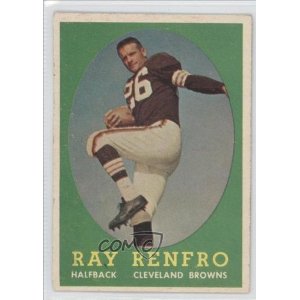
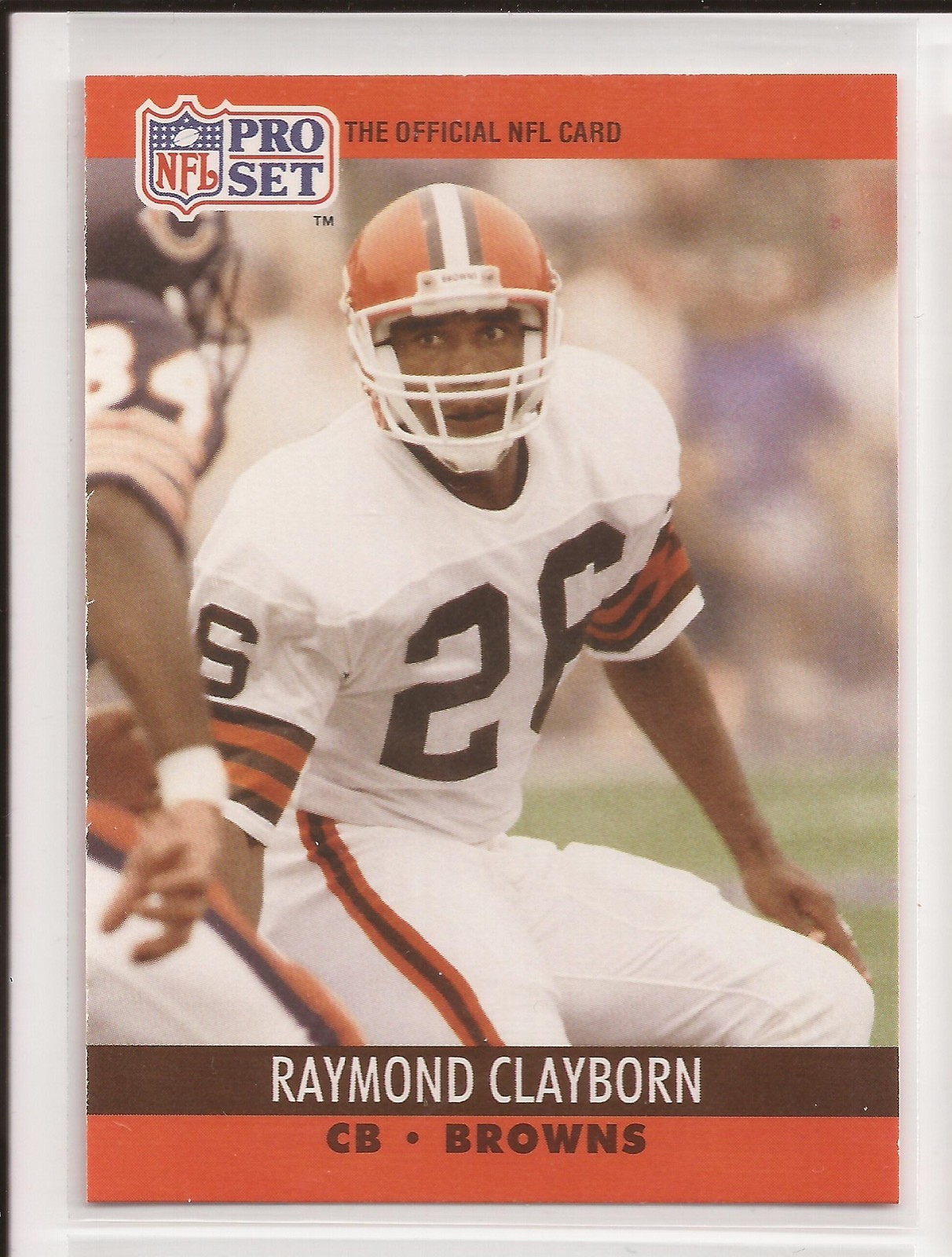 play there.) Jacoby had some up and down seasons- mostly up. Several of his seasons rivaled Powell’s 1975. The winner is Jacoby.
play there.) Jacoby had some up and down seasons- mostly up. Several of his seasons rivaled Powell’s 1975. The winner is Jacoby.
Raymond Clayborn is the competition for Ray Renfro in first round on the Browns’ side. This is no contest. Clayborn had a nice career, but that was mostly with the Patriots. Browns owner Art Modell’s choice of granting him an outlandish free agent contract in 1990 helped to lead to his excuse that he had “no choice” but to move Cleveland’s heart and soul to Baltimore in 1995. The only remaining redeeming value of Clayborn is the recent obsession of Twitter follow @love_that_goku’s over Clayborn’s wife, the dearly departed Lisa “Left Eye” Lopes.
Renfro’s longevity with the Browns alone is enough to advance him past Clayborn.
The Dino Hall/Ron Wolfley matchup pits two running backs against each other. Additionally, each ‘made their money’ as special teams standouts.
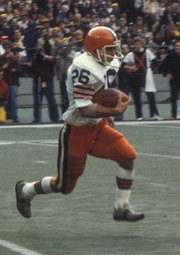
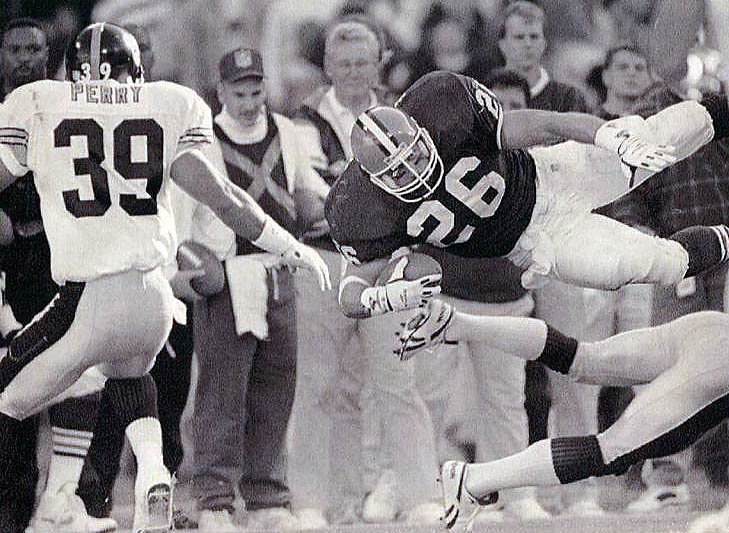 The credit for the signing of Dino Hall (left) goes to Browns coach Sam Rutigliano. The reason the 5’7” (if that) returner went undrafted was his height. His foot speed and competitive heart kept him in with the team for five seasons.
The credit for the signing of Dino Hall (left) goes to Browns coach Sam Rutigliano. The reason the 5’7” (if that) returner went undrafted was his height. His foot speed and competitive heart kept him in with the team for five seasons.
Coach Sam actually cut Hall in 1979. He brought him back when starting returner Keith Wright went down with a knee injury in October.
While Ron Wolfley was listed as a fullback, his value was as a standout cover guy on kicks. He was a fan favorite- when he made a play, the crowd would respond as he walked to the sideline in an animated manner. His uniform would often be muddied, his jersey untucked…
An interesting anecdote about Wolfley: Browns fans smile at the memory of another Browns running back, Leroy Hoard. He is credited with the statement, “If you need a yard, I’ll get you three. If you need five yards, I’ll get you three.” According to Wolfley, he originally made that comment in a conversation with Hoard. Prior to a future Monday Night Football game, Hoard used that while speaking with announcer John Madden. Madden shared that during the game, and Hoard has owned it ever since.
Hall vs. Wolfley is a tough one. Due to playing with the Browns longer, and through his entire career, Hall gets the nod.
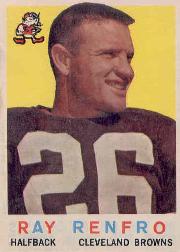 In the Wickman/Jacoby matchup, the third baseman Jacoby can boast of two All-Star appearances (1986 and 1990). He actually had his best year statistically in 1987, the season the national publications stunningly (and wildly incorrectly) picked the Indians to win the pennant. He hit an even .300 in ‘87, with 32 home runs. He struck out only 73 times that entire season.
In the Wickman/Jacoby matchup, the third baseman Jacoby can boast of two All-Star appearances (1986 and 1990). He actually had his best year statistically in 1987, the season the national publications stunningly (and wildly incorrectly) picked the Indians to win the pennant. He hit an even .300 in ‘87, with 32 home runs. He struck out only 73 times that entire season.
Bob Wickman was also a two-time All-Star (2000 and 2005). He was the American League saves champion in 2005, with 45. His saves were famously adventurous; if the Indians were ahead by more than one run, he often seemed to allow the opponent to creep closer. (Maybe that was what he thought the term ‘closer’ meant.)
Both Jacoby and Wickman were well-liked by the fans. Wickman played on better teams… The clincher is that Bob Wickman remains the all-time saves leader for the Indians, with 130. Wickman advances.
With all due respect to Dino Hall, special teams players just cannot measure up to the kind of consistent production Ray Renfro gave the Browns. Renfro was a favorite deep target of quarterbacks Otto Graham and Milt Plum. He totaled 55 touchdowns, and they mattered- the Cleveland Browns were among the best teams in the NFL.
 We’ve pretty much laid out the high points of Bob Wickman’s service to the fans of Cleveland. He was great. He’ll be remembered fondly for years to come. Ray Renfro, on the other hand, perhaps gets forgotten among Browns fans- he played generations ago, and several other Browns of his era were even more prominent.
We’ve pretty much laid out the high points of Bob Wickman’s service to the fans of Cleveland. He was great. He’ll be remembered fondly for years to come. Ray Renfro, on the other hand, perhaps gets forgotten among Browns fans- he played generations ago, and several other Browns of his era were even more prominent.
Renfro’s Browns career began inconspicuously- he returned kicks for a couple seasons, and had a problem with holding onto the ball. In 1953, he was asked to step up and assume some of the load at running back. Marion Motley’s Hall of Fame career was succumbing to knee injuries. Renfro suddenly became reliable as a vital cog in the offense, only fumbling twice over the next ten seasons. During that stretch, the Browns played in five NFL championship games, winning two.
What Ray Renfro perhaps lacked in ideal size, he more than made up for with his tremendous speed. Shooting out of the Browns’ backfield, he was a matchup nightmare for defenses of his time. Coach Paul Brown eagerly exploited the mismatch. Renfro was a home run hitter for the Browns.
Ray Renfro retired in 1961. Paul Brown talked him into returning, as a player-coach. He hung up the spikes for good in 1963.
It's Renfro!
- NBA Announces 2013-2014 Schedule
- Browns Ink Sharknado
- Sharknado A No-Show For Rookie Camp
- Trent Richardson Out Until Training Camp
- Browns Sign Brandon Jackson
- Carrasco Suspended Eight Games
- Browns Add to Wide Receiver Depth with David Nelson
- Browns Need to Learn from Past Draft Mistakes
- Browns Release Chris Gocong and Usama Young
- Browns Missing on Grimes Disappointing, But Not The End
The TCF Forums
- Official- Browns Coach Search/Rumors
mattvan1 (Tuesday, January 21 2014 1:19 PM) - Movies coming out
rebelwithoutaclue (Tuesday, January 21 2014 12:56 PM) - 2015 Recruiting
jclvd_23 (Tuesday, January 21 2014 12:38 PM) - The 2014 Offseason Thread
Larvell Blanks (Tuesday, January 21 2014 12:25 PM) - Chris Grant's first 3 drafts
Kingpin74 (Tuesday, January 21 2014 10:13 AM) - Mike Brown
YahooFanChicago (Monday, January 20 2014 11:15 PM) - 2014 Hoops Hockey Hijinx
jpd1224 (Monday, January 20 2014 4:44 PM) - 2014 Recruiting
jclvd_23 (Monday, January 20 2014 2:26 PM) - Wish List - #4 Pick
Hikohadon (Monday, January 20 2014 1:26 PM) - #1 overall pick Anthony Bennett
TouchEmAllTime (Sunday, January 19 2014 1:28 PM)


